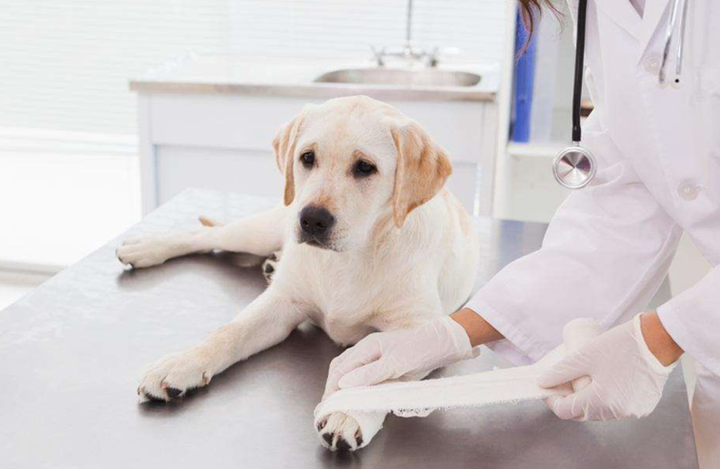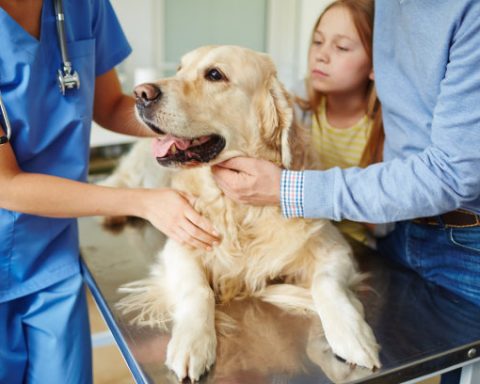Car Accidents:
You may have witnessed a car accident or found that your cat or dog has a significant injury or limp, this time, if possible, you should be given to him to bandage the wound to prevent aggravation of the injury. Where bleeding is evident, apply ice and pressure to stop the bleeding, but overall keep your dog’s body temperature warm and as comfortable as possible. Do not move the injured pet recklessly and contact your veterinarian immediately for more detailed instructions. Owners should not leave their pets unattended on the floor and should stay with their injured pets as long as possible.
If an injured pet must be removed from the scene of an accident, the owner should find two more helpers, put a cloth or blanket or something like that under the injured pet, and pay attention to the action to be slow and gently move him to the blanket. The injured pet will be moved to the center of the blanket, by two people were pulled tight blanket on both sides, another person should be found to support the pet’s back, in order to parallel the pet’s weight.
Eye Injuries:
If you find that your pet’s eye is suddenly in great pain, or that it won’t stay open, then look carefully for an obvious foreign object, especially a glass. If you find that your pet’s eyes are suddenly in great pain or are unable to stay open, then you should carefully look for obvious foreign objects, especially glass shards, and then carefully remove them, or you can use cotton dipped in clean, hot water or pet-specific eyedrops to clean their eyes and flush out the foreign objects. Do not leave your pet in a bright environment. After the initial cleaning and care, you should take your pet to a doctor. If it is not possible to go to the doctor immediately, a few drops of medicinal olive oil can be put in the eyes as a first aid. After the accident, the owner must prevent the pet from rubbing the injured eye or scratching the eye with something.
Bleeding:
If your pet is cut by a sharp object and bleeds profusely, the owner should hold the bleeding wound for about a minute with a cotton pad. If the pressure in a minute, the bleeding situation is still not improved, then the location of the bleeding with a bandage on about five centimeters of the site, which can prevent part of the blood flow into the wound location. However, this should not be done for too long as the area below the wound will not receive enough blood supply and may become necrotic. If the area below the wound is purple-blue in color or is too swollen, the bandage has been in place for too long and should be removed immediately. If your pet is bleeding profusely, wrap the wound in cotton and tie it tightly with a bandage, do not use elastic string or other structural materials to wrap the wound, and take him to the doctor as soon as possible after treating the wound.
Fractured limbs and bones:
If you find that your pet has a fractured limb, i.e., they are walking around or staggering, these are the pets that have broken bones. Owners should try not to let their pets move, and prevent touching the affected area so that the broken bones don’t easily cut blood vessels or nerve wires. If the injured dog is a small dog, the owner should place it in a wooden crate or airplane cage to minimize its range of motion. If the owner has been trained in pet first aid, he or she may be able to immobilize the fracture with a splint, but if the owner has not been trained, he or she can use the following methods, or seek veterinary help.
1. Roll the fracture in cotton and tie it with a bandage to minimize the shock of movement.
2. Place two suitable and sturdy boards on either side of the fracture and wrap securely with bandages.
Scalded or Burned:
If the pet is accidentally spilled hot water or hot soup or accidentally burned by the fire, the owner has to rinse the injured area with water immediately. If possible, it is best to keep the water running for about ten minutes. This is because the pet’s fur is so thick that it takes a while for the water to penetrate the skin at the root of the fur, and because hot water is not easy to cool down, so having a constant stream of water running over the wound will help to moderate the high temperature on the skin surface and minimize the damage to the skin tissues. Sometimes owners will apply ice to the affected area, but do not leave it on for too long or the skin will die quickly. Don’t let them lick the burns too much as this will increase the chance of bacterial infection.
Owners should not bandage the wound for too long as this can cause it to become inflamed. In addition, don’t apply any disinfectant to the wound, as these medications can kill the skin faster and can cause poisoning if the pet licks the medication. So don’t use anything other than water or light salt water to clean burns or scalds. Although some people recommend applying an ointment containing oil to the wound, this is intended to lower the temperature of the skin, and if the wound has already been cleaned with water, no further medication should be applied. Once the initial first aid has been given, it is important to take them to the veterinary hospital as soon as possible.
Heat Stroke:
When the summer sun shines, if you leave your pet in a place where there is no air circulation or exposure to the sun, it may cause heat stroke. If your pet suffers from heatstroke, you need to move your pet to a cool, shady place immediately and never give it direct sunlight again. When you get your pet to a cooler place, run cold water over his body, especially his head, which needs to be cooled down. Pets with heatstroke do not need to be doused with large amounts of water, just cover them with a soaked towel, and do not give them large amounts of water, just small amounts. If your pet is unconscious, take them to a veterinarian immediately. Pets suffering from heat stroke may develop pneumonia, so owners should keep an eye on their pet’s breathing.
Poisoning:
Pets may become very ill, faint or have muscle spasms. If you see your pet swallowing something known to be poisonous, you can induce him to spit out as much of the poison as possible by pouring salt water down his throat {a teaspoonful of salt in a cup of water for an average-sized pet. If the substance swallowed is corrosive, give him milk. If your pet is already unconscious, these methods should never be used, but you should go to a veterinarian as soon as possible, and take with you the rest of the poisoned substance and its packaging, which will help the veterinarian to treat the poisoned pet. In addition, poisoning can sometimes be caused by toxic substances such as detergents getting on the pet’s fur and entering the body through licking. If this is the case, owners can clean their pets thoroughly with a pet cleaner to prevent them from licking the toxic substance again.

